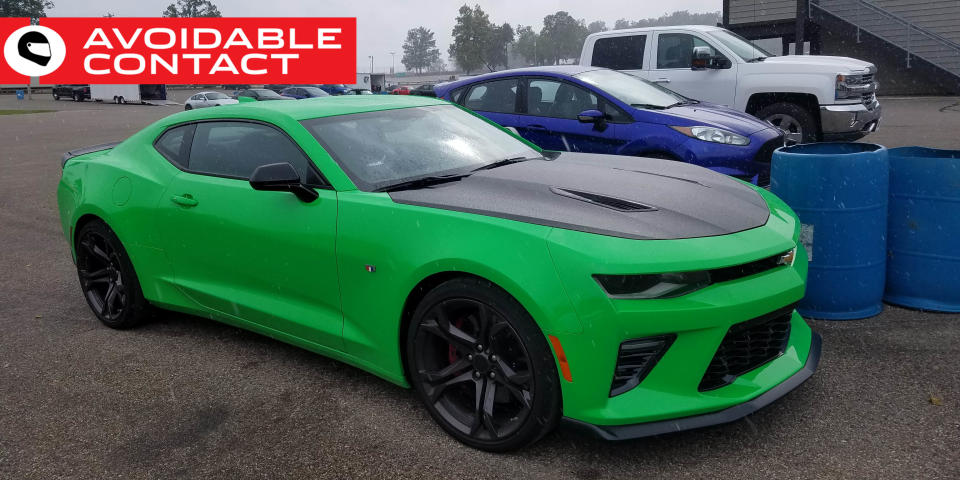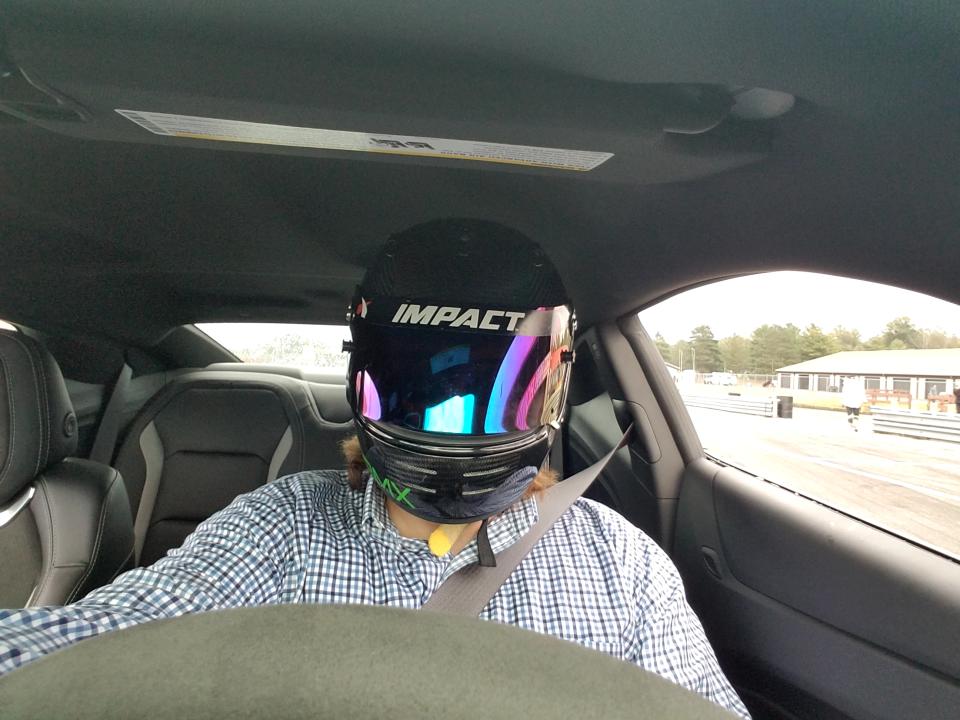Rainy Mondays Can't Get the Camaro SS 1LE Down

What do you when you have a 455-horsepower ponycar at your disposal and a whole evening to spend at one of America’s greatest road courses–but the track is too wet for comfort? The obvious thing to do is to use a track dryer. NASCAR has the Air Titan 2.0 that uses a complex system of compressed air and heat to get the track surface ready for racing action. It’s extremely impressive, but it’s also extremely expensive.
Surely there’s a cheaper way, and it turns out that there is a cheaper way, at least for R&T Deputy Editor David Zenlea. When he arrived at Mid-Ohio a few weeks ago only to find that a massive rainstorm had passed through just minutes earlier, Mr. Z did the obvious thing: he told me to take his wicked green Camaro SS 1LE around the track until the racing line was nice and dry.
Maybe it was an abuse of the man’s power, but I was happy to oblige. The sixth-generation Camaro might be a bit of a mixed bag on the street thanks to its claustrophobic greenhouse and bewildering interior ergonomics (why is the infotainment screen angled DOWN, I ask you?) but when you get it on a racetrack it shines brightly enough to be seen from the International Space Station. The naturally-aspirated SS 1LE is arguably the best-balanced and most track-friendly member of the extensive Camaro lineup, lacking the ZL1’s raw pace but also lacking that car’s monstrous appetite for tires and brakes.
There’s something about that black hood and squinty face that brings out the 12 year old in me.
There’s something about the black hood and squinty face of the current 1LE that brings out the twelve-year-old in me. I was smiling from ear-to-ear as I hopped in and adjusted the seat and steering wheel. Although the roof feels and looks low, there’s plenty of room for a six-foot-two driver in a helmet and the controls, as they used to say in this magazine before the Nixon Administration, all fall readily to hand.
Selecting “Tr” mode with the console rocker switch to preserve a bit of a wet-weather safety blanket, I headed out on pit lane and promptly splashed through standing water in the exit of Turn One. Whatever wheelspin I managed to generate in so doing was promptly arrested by the traction control and I rocketed towards the “Club” chicane that Mid-Ohio adds to the track on these summer evenings. The LT1 engine is nearly as impressive in the Camaro as it is in the Z51 Corvette, running hard to the redline and never feeling out of breath.
It’s probably safe to say that pretty much every electric power steering system on the market today does something to disguise the interaction of tire and tarmac; the variant fitted to the 1LE is no exception. Still, the F-body has never been known for purity of feedback and at least the steering effort is free of the nasty stiction-like irregularities that some of the older hydraulic-steering Camaros could display. It’s well matched to the shift effort, which requires nothing more than fingertips. If you’re used to an older Corvette or Camaro, this new car will seem almost absurdly civilized despite the uncouth roar from the exhaust.

I’d expected the twenty-inch Goodyear F1 tires to be troublesome in standing water but in truth they were no better or worse than the 180-treadwear tires seen on most modern performance cars. As the track dried out over my first three laps, I found that they could make ready use of dry patches on the track even if said patches weren’t up to the 285mm front or 305mm rear tire width.
After watching three cars loop out in front of me in just a few minutes, I was at least emotionally prepared for the moment that I’d find less traction than I expected. somewhere. The bottom of Mid-Ohio’s “Madness” section is famous for retaining water and staying slippery even if it looks dry-ish, so it was no real surprise to find the Camaro sliding off-track towards the well-known Honda bridge before Turn 10. This was the authentic four-wheel slide, which meant that the stability control had no real ability to affect matters. Luckily for me, I was only doing maybe fifty miles per hour and I knew that I had a solid chance of finding dry pavement right before the edge of the track, so I kept my foot halfway in it and the 1LE clawed its way from that edge over the Turn 10 hill towards the braking mark for the turn into Thunder Valley.
Make no mistake, even after some well-publicized weight loss the Camaro is not a small car by anybody’s standards. Yet it does a pretty decent job of shrinking around you at speed, and the sheer capacity of the car means that unless you’re sharing the track with supercars you don’t need to worry too much about the view through that gun-slit read window. As the track dried out, the brakes heated up and the pedal started to sink a bit. It’s nothing you couldn’t fix with the appropriate pads and fluid. For that reason alone, I’d be inclined to pick an SS over a ZL1. The physics problems posed by a 650-horsepower variant of this two-ton sedan are difficult for any manufacturer-supplied equipment to easily solve.
In a world where you never drove your ponycar away from the track, this would be the ponycar to have
By the time the entire racing line was dry I was an unabashed fan of this far-from-bashful green Camaro. In a world where you never drove your ponycar away from the track, this would surely be the ponycar to have. It displays a genuine aristocracy of touch at very high speeds in very fast corners and it doesn’t feel overmatched by its curb weight in the slow ones. Having recently driven an M3 Competition Package on this same course, I have no trouble expressing a clear preference for the Chevrolet in pretty much all areas from power delivery to midcorner balance.
You could argue that not much has changed in the ponycar market over the past twenty-five years. In 1992 the Camaro was sleeker, faster, more comfortable on track, and far more intimidating-looking. The Mustang, by contrast, prioritized everyday usability, an upright greenhouse, and handling that seemed better suited for the road than for the track. Well, here we are in 2017 and the same cars are here offering basically the same virtues as they did back then. If I wanted a V-8 two-door for the daily commute, I’d pick the Mustang GT and never think twice about it.
As a dual-purpose trackday toy, however, this SS 1LE fears nothing short of a GT350 and it’s certainly superior to anything else you could buy for the same money. I wouldn’t change a thing about it. Well, maybe one thing... Surely any Camaro with this much swagger deserves at least the option of being called an IROC-Z. Some of us would appreciate the shout-out to an era where almost nothing out there could touch a Camaro around a racetrack. Those days are back.
You Might Also Like

 Yahoo Autos
Yahoo Autos 